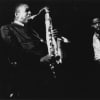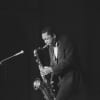Each Tuesday, FADER editor Matthew Schnipper highlights an underappreciated release he thinks we need to know about. This week it’s Marion Brown's Afternoon of a Georgia Faun. Listen to clips from the record and read Schnipper’s thoughts after the jump.
In 1964, legendary tenor sax player Archie Shepp recorded Four for Trane. Exactly what it says, the album was four Coltrane tracks from Giant Steps as rearranged played by Shepp and his band. (There is also a fifth, non-Coltrane authored song, “Rufus (Swung his Face at Last to the Wind, Then his Neck Snapped)." The cover of the album is Shepp and Coltrane in muted color, Shepp with a pipe and rolled shirtsleeves, sitting on some steps, Trane lounging behind and to the left, shadow mentor. He’s got a jacket on, clearly the adult. This was three years before he died, and around the time his music began to get completely cosmic. That interstellar crawl was assisted heavily by Shepp, a younger, often shriekingly aggressive sax player.
But before Coltrane died unexpectedly of cancer, things were beginning to coalesce—stylistically, at least. His last recordings hinted at a sound both absolutely loud and unconstrained, but still tender and loving. He’s adopted Shepp into his group, mostly shedding the players of the Classic Quartet for his more barreling accompanists. Shepp, probably empowered by the embrace of an idol, himself became a strong leader. It’s a few years before July of ’67, when Coltrane died and when, without a spiritual leader, jazz got fully zooted, with a heavy migration to Europe to record in a freer place. So it makes sense that in not yet freeform 1966, in a jazz world teetering on the edge of a welcome and nearing wild cacophony, though still foundationally settled, Marion Brown made his own tribute to his leader, Archie Shepp. Brown himself had played with Coltrane, most notably on the huge-group recording, Ascension, but was a younger and less keynote artist. Shepp had a bigger personality (soon would have great sunglasses and bushy beard to match, too), and Brown just didn’t seem the pushy type. On the cover of Three for Shepp—which also includes three brown originals—they are photographed next to each other, one saxophone for the two of them. Brown is slightly more forward, a bit more pointed to the camera, but Shepp is there, beveled against him. There’s certainly no sign of beef, but this was a macho genre fixated on ideas of power. To imagine free love reigned infinitely seems unlikely. And though he too spent time in Europe, maybe that’s why Marion Brown went back home to Georgia.
Afternoon of a Georgia Faun was released on ECM a decidedly uncool record label. On the record, as if trying to out-geek himself, Brown is clear to mark one of the player’s instruments as the “top o’lin,” which he himself invented and is “an instrument made by attaching tops of cooking pots to a board. It is played with a violin bow, or struck.” The album is just two pieces, the title track and “Djinji’s Corner”—about his son Djinji Brown, who would later grow to be an instrumental hip-hop producer. “Djinji’s Corner” is certainly much closer to the atom-splitting extension of jazz Coltrane was prescribing, disjointed saxophone, random piano and jittery drums strewn across a nearly twenty minute song. It’s impressionistic, sure, but it retains a methodology. This, as Brown writes on the album’s liner notes, was prescribed amidst the chaos. “Each musician has a station that consists of his primary instrument, secondary instruments and miscellaneous instruments. The players move from station to station playing their instruments as well as other instruments. He remains at the station for a minute, then goes to another station to begin a new phrase, or to continue developing a subsequent phrase. The composition ends with a blast from a whistle after which the players return to their original station to complete the composition.” The song is as nerdy as that sounds. It’s also the less good of the two.
It was really nice this weekend for the first time and I put on Loaded by the Velvet Underground and scrubbed my countertops with the doors and windows open. I’ve always loved the first and last songs on Loaded, my favorite moment being the guitar solo finale of “Oh! Sweet Nuthin.” But my favorite song has always been “Who Loves the Sun.” For the first hints of springtime, it’s a perfect song, slivers of sunlight through unexpecting blinds. Nothing is happier than that. I’ll have to check the weather in 1970, because that’s the year both Loaded and Afternoon were released. “Who Loves the Sun” is ostensibly a breakup song (Who loves the sun…/ Not everyone…/ Since you broke my heart), but its wordless pa pa pas are so blissful, any pissy direct meaning they’ve infused is overtaken by breathy love of mother earth. The same is true of “Georgia Faun.” “’Afternoon of a Georgia Faun’ is a tone poem. It depicts nature and the environment in Atlanta. The vocalists sing wordless syllables,” writes Brown. They definitely do. And though by nature, the music coming from their instruments is wordless, too, it’s performed in the same baby talk. There are traditional instruments (piano, flute) and real musicians (Chick Corea, Anthony Braxton), but “Georgia Faun” is a gentle reproduction of a hazy vibe. People whisper, sing lightly, scrub strings with fingernails, tap bells. Five and a half minutes in, there is the introduction of an alto sax. It sounds like a noise from a safari. It’s sustained, accompanied by slide whistles and tongue trillings, before all sounds exit completely for Chick Corea’s piano solo, which begins with a small, creeping roar and then plinks around the keys, eventually finding some routine solace in pretty chords. Then it skips away, spritelike. The rest of the piece is a jumble, piano, flute, wordless singing. “’Afternoon of a Georgia Faun’ is a tone poem.” Yeah, no kidding.
What happened in those years between Coltrane in a blazer and Marion Brown in a dewy field? In 1969, Archie Shepp recorded in Algiers with a drum heavy group of North African musicians. You can barely hear the sax. Albert Ayler, who had played at Coltrane’s funeral at his own request, washed up in a river. Alice Coltrane, John’s widow, got cosmic and southeast Asian, a transcendental reality replacing an earthen one. He certainly abandoned some of his earlier screech for something uniquely beautiful. Maybe the European jazz exodus was in essence a mourning, the crappy America so always lamented no longer even featuring its tenor king. And so then this is what it was like when they came home. But not to New York, with drugs and lofts, home to the wilderness. Despite all of that, Afternoon was recorded in the city, early August. It was probably hot out like it always is here, and for most of the players, the caking pavement was probably the closest they’d gotten to southern heat. Marion Brown probably directed them, surely with some passionate fervor if not quite loosely, and told them to follow their imagination. “Although I am responsible for initiating the music, I take no credit for the results,” he writes. “Whatever they may be, it goes to the musicians collectively.” That appreciation for a collective, so separate from the strong posturing that created so many otherworldly titans in jazz, is what flows through Afternoon. Maybe it’s the same thing that flows through “Who Loves the Sun.” Ostensibly selfish, Lou Reed channeled that into a hazy melody, the same effect as Brown, just a different cause. So who knows why things got so strongly disparate after Coltrane died. But at least they got there.


